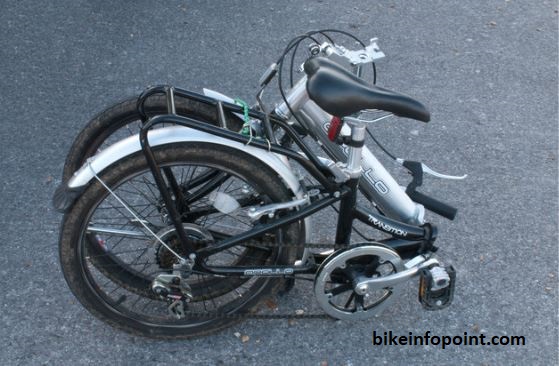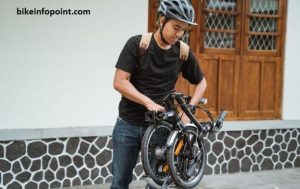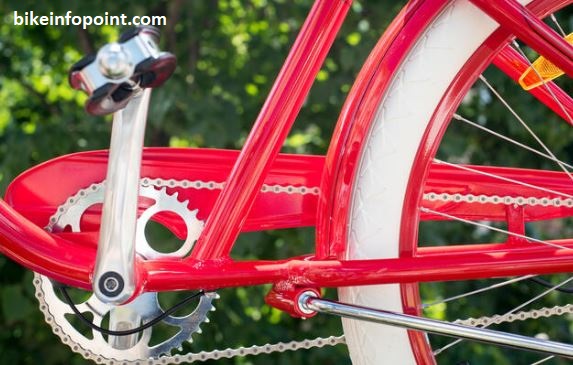
What is Folding Bike
A folding bike, also known as a foldable bike, is a compact and portable bicycle designed to fold into a more manageable size. This feature allows for easy storage, transport, and carrying, making it a versatile option for various commuting and recreational purposes.
Key Features:
Folding Mechanism: The defining feature is its ability to fold, usually facilitated by hinge joints and adjustable frame sections.
Compact Size: The bike can be reduced to a fraction of its unfolded size, making it convenient for storage in small spaces.
Table of Contents
ToggleBrief History of Folding Bikes
Origins: Folding bikes have a rich history dating back to the late 19th century. The concept gained traction as a solution for space constraints and increased urbanization.
Evolution:
Pre-World War I: Early folding bikes were characterized by simple hinge designs and collapsible features.
Post-World War II: Folding bikes experienced a resurgence as urban transportation needs changed, leading to advancements in design and materials.
Contemporary Era: Technological innovations and a focus on sustainability have further propelled the development of folding bikes.
Design and Structure
A. Folding Mechanisms
1. Hinge Joints
Types of Hinge Mechanisms:
Mid-Fold Hinge: Found in many folding bikes, it allows the bicycle to fold in half, reducing its length.
Triangle Hinge: Commonly used in compact folding bikes, it enables the bike to fold into a more triangular shape, further reducing its size.
Telescopic Hinge: Involves sliding tubes into each other, collapsing the frame in a telescopic manner.
2. Frame Geometry
Adjustable Frame Sections:
The frame is often designed with adjustable sections that allow for folding without compromising structural integrity.
Locking Mechanisms: Secure mechanisms are crucial to ensure the frame remains stable during use.
B. Materials Used
1. Frame Materials
Aluminum: Lightweight and corrosion-resistant, aluminum is a popular choice for folding bike frames.
Steel: Provides durability but tends to be heavier than aluminum. Commonly used in mid-range folding bikes.
Carbon Fiber: High-end folding bikes may incorporate carbon fiber for its exceptional strength-to-weight ratio.
2. Components
Hinges and Joints: These components are typically made from durable metals like stainless steel to withstand frequent folding and unfolding.
Gearing Systems: Folding bikes often feature a range of gearing systems, from traditional derailleurs to internal hub gears.
C. Size and Weight
1. Folded Size
Compactness: Folding bikes vary in the degree to which they can be compacted. Some fold into a very small size suitable for carrying onto public transportation or storing in tight spaces.
Ease of Folding: The efficiency of the folding mechanism impacts how quickly and easily the bike can be folded and unfolded.
2. Weight Considerations
Lightweight Models: Manufacturers prioritize using lightweight materials to enhance portability, crucial for commuters who may need to carry the folded bike.
Trade-offs: There is often a trade-off between weight and durability, with high-end models using advanced materials to balance these factors.
What is a Folding Bike Tire?
Types of Folding Bikes
A. Compact Folding Bikes
1. Brompton
Design Features:
Triangular Fold: Brompton bikes fold into a compact and distinctive triangular shape, making them highly portable.
Small Wheels: Equipped with smaller wheels, contributing to the overall compactness.
Use Cases:
Ideal for commuters who need a bike that can be easily carried onto public transportation.
Suited for urban environments with limited storage space.
2. Tern
Foldable Pedals and Handlebars: Tern bikes often feature foldable pedals and handlebars, further reducing the overall folded size.
Versatility: Tern models are designed for both urban commuting and recreational riding.
Adjustable Seatpost: Some Tern models come with an adjustable seat post, allowing riders of different heights to comfortably use the bike.
B. Mid-fold Folding Bikes
1. Dahon
Mid-Fold Design: Dahon bikes typically fold in the middle, creating a more elongated shape compared to compact models.
Wheel Sizes: Available with a range of wheel sizes, offering a balance between compactness and ride comfort.
Variety of Models: Dahon offers a diverse range of models catering to different preferences and riding styles.
2. Strida
A-Frame Design: Strida bikes have a unique A-frame design, allowing for a quick and easy folding process.
Belt Drive System: Some Strida models feature a belt drive system, reducing maintenance needs and providing a clean aesthetic.
Upright Riding Position: Known for an upright riding position, suitable for short commutes and urban navigation.
C. Full-size Folding Bikes
1. Montague
Full-Size Performance: Montague bikes maintain the performance and ride quality of a full-size bike when unfolded.
Folding Frame: These bikes fold at the frame joints, preserving the overall geometry for a more traditional riding experience.
Applications: Suitable for riders who prioritize performance and want a folding bike for longer commutes or recreational rides.
2. Change Bike
Mountain Bike Adaptation: Change Bike models cater to the off-road enthusiast, featuring a folding design suitable for mountain biking.
Folding Frame and Handlebar: Designed to fold at the frame and handlebars, maintaining off-road capabilities when unfolded.
Terrain Versatility: Ideal for those who want the flexibility to combine mountain biking with other modes of transportation.
Advantages of Folding Bikes
A. Portability and Storage
1. Compact Size:
Ease of Storage: Folding bikes can be stored in small spaces, such as closets, under desks, or in the trunk of a car, making them ideal for individuals with limited storage space at home or work.
Apartment Living: Well-suited for apartment dwellers who may not have access to secure bike storage facilities.
2. Easy to Carry:
Public Transportation: The ability to fold makes them convenient for combining cycling with other forms of transportation, such as buses, trains, and subways.
Carrying Upstairs: Easy to carry upstairs, making them practical for riders who need to navigate buildings without elevators.
B. Multimodal Transportation
1. Seamless Integration:
Door-to-Door Commuting: Folding bikes enable a door-to-door commute, allowing riders to cycle from home to a public transportation hub and then from the destination station to their final destination.
Reduced Waiting Times: Avoid waiting for the next bus or train by using a folding bike to cover the last leg of the journey.
2. Flexibility in Urban Settings:
Traffic Mitigation: Bypass traffic congestion by easily switching between cycling and public transportation.
Parking Convenience: Folded bikes can be stored more easily and securely than traditional bikes, eliminating concerns about bike theft.
C. Security and Theft Prevention
1. Indoor Storage:
Reduced Theft Risk: Folding bikes can be brought indoors, reducing the risk of theft compared to leaving a bike locked outside.
Office and Workplaces: Convenient for riders who can store their folded bikes at their workplace, minimizing exposure to theft.
2. Portability as a Theft Deterrent:
Take Anywhere: The ability to take the bike with you wherever you go serves as a deterrent for potential thieves.
Less Targeted: Folding bikes are often perceived as less attractive targets for theft due to their distinctiveness and limited market for stolen folding bike parts.
Challenges and Considerations
A. Cost
1. Initial Investment:
Higher Initial Cost: Folding bikes often come with a higher upfront cost compared to traditional non-folding bicycles. The engineering required for the folding mechanism and the use of lightweight materials can contribute to this higher cost.
2. Variability in Price:
Quality and Features: The cost of folding bikes can vary widely based on factors such as the quality of materials, brand reputation, and additional features like integrated lighting or electronic components.
Trade-offs: Lower-cost models may sacrifice certain features or use less advanced materials, affecting overall performance and durability.
B. Ride Quality
1. Frame Rigidity:
Trade-off for Portability: The folding design can sometimes result in a less rigid frame, affecting the overall stability and ride quality compared to non-folding counterparts.
Varied Suspension Systems: Some folding bikes incorporate suspension systems to mitigate the impact on ride quality, but this can add weight and complexity.
2. Wheel Size Impact:
Smaller Wheels: Many folding bikes have smaller wheels, which can impact ride comfort, especially over rough terrain. However, advancements in design and materials aim to address this concern.
C. Maintenance
1. Complexity of Folding Mechanism:
Potential for Wear: The folding mechanism, especially if not well-maintained, can be susceptible to wear over time. Regular cleaning and lubrication are essential to ensure smooth operation.
Specialized Parts: Some folding bikes may have specialized components, and finding replacement parts could be more challenging compared to standard bicycles.
2. Tight Tolerances:
Precision Maintenance: Folding bikes often require precise adjustments to maintain the proper functioning of the folding mechanism. This may necessitate professional maintenance or a higher level of DIY expertise.
Risk of Misalignment: Misalignment of folding joints can lead to issues with the folding process and affect overall ride quality.
Popular Uses and Demographics
A. Commuting
1. Last-Mile Solution:
Public Transportation Integration: Folding bikes are popular among commuters who rely on public transportation. They serve as a last-mile solution, allowing users to cover the distance between transit stops and their final destination.
Office Commutes: Ideal for individuals commuting to work in urban areas where space constraints and limited parking options make traditional bikes less practical.
2. Multimodal Commuting:
Combining Modes: Commuters often use folding bikes in conjunction with other transportation modes, such as buses or trains, to create a seamless and efficient commuting experience.
Reduced Commute Times: By avoiding traffic congestion and waiting times, users can potentially reduce their overall commute time.
B. Urban Cycling
1. Navigating Urban Environments:
Maneuverability: Folding bikes excel in urban environments, offering easy maneuverability through traffic, narrow streets, and crowded areas.
Storage in Tight Spaces: Well-suited for apartment living, as they can be stored indoors and easily carried up stairs.
2. Avoiding Theft Concerns:
Security Benefits: Folding bikes can be brought indoors, reducing the risk of theft compared to leaving a bike locked outside in urban areas.
Office Storage: The portability of folding bikes makes them convenient for storing in offices and workplaces.
C. Recreational Riding
1. Versatility for Exploring:
Exploration and Tourism: Folding bikes are popular among tourists and recreational riders who want the flexibility to explore a city or natural landscapes on two wheels.
Easy Transportation for Vacations: The ability to fold makes it easier to bring a bike on vacations, enhancing opportunities for recreational cycling.
2. Compact Storage for Hobbies:
Hobbies and Hiking: Enthusiasts of hiking or outdoor activities can use folding bikes as a compact and portable means of transportation, providing an alternative to walking.
D. Demographics
1. Urban Dwellers:
Space Constraints: Individuals living in urban areas with limited storage space or without dedicated bike storage facilities often find folding bikes more practical.
Public Transportation Users: Those who rely on public transportation find folding bikes convenient for the last leg of their commute.
2. Business Professionals:
Office Commuters: Professionals who commute to work and want a compact and portable transportation option that can be easily stored in an office.
Flexibility for Meetings: Business travelers may use folding bikes to navigate urban areas for meetings or conferences.
3. Tourists and Travelers:
Easy Transportation: Tourists and travelers appreciate the ease of transporting folding bikes, allowing them to explore new destinations on their terms.
Compact Storage in Hotels: Folding bikes can be stored in hotel rooms, providing added convenience for travelers.

